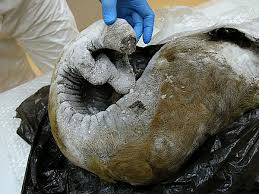Scientists are seeking to unlock unknown prehistoric viruses up to 50,000 years old by extracting biological material from carcasses of ancient animals frozen in permafrost, according to reports.
The Russian team is this week reportedly taking samples from a collection of beasts preserved in ice that have been found in recent years.
They are working with the remains of extinct woolly mammoths and hairy rhinos, as well as prehistoric dogs, horses, elk, rodents, and hares.
The oldest animal is believed to be a 50,000-year-old lemming.
The work is spearheaded by Vector State Research Centre of Virology and Biotechnology, once a Cold War biological warfare research plant established by Soviet leader Leonid Brezhnev.
The high-security facility near Novosibirsk in Siberia is currently developing Russia’s second Covid-19 vaccine to compete with better-known Sputnik V.
Scientists took 50 samples on Tuesday, February 16 from ancient beasts, and expect to gather the same number on Wednesday from carcasses held at the Mammoth Museum of Russia’s North-Eastern Federal University in Yakutsk, the world’s coldest city.
Vector scientist Dr Olesya Okhlopkova said: “We want to find palaeo-viruses making it possible to start the development of palaeo-virology in Russia.”
The aim is to “conduct advanced research” in the “evolution of viruses”, but experts have previously warned that delving back into the past could pose a threat from zombie infections.
She was taking samples from the soft tissue of the long-gone animals.
Dr. Okhlopkova said they would attempt “whole-genome sequencing, with which scientists can obtain data on the entire biodiversity of microorganisms in a sample.
“If the nucleic acids were not destroyed, we will be able to obtain data on their composition and establish how it changed, what was the evolutionary development of events.”
They hope to understand “significant trends” in the development of viruses since prehistoric times to glean the “epidemiological potential of currently existing infectious agents”.
The animals have been found over the last decade or so as permafrost has thawed in the Arctic and subArctic.
Dr Maxim Cheprasov, acting head of Mammoth Museum, said: “The first find with a selection of soft tissues was the Verkhoyansk horse in 2009.
“The scientific value of the find lies in the fact that its complete nuclear genome was deciphered, thanks to which the history of the origin of the modern Yakut horse became known.”
These horses are able to survive in temperatures as low as minus 60C.
Museum scientist Dr. Sergey Fedorov said: “The Mammoth Museum has long-standing ties with the Vector.
“We hope that palaeo-viruses will be found and interesting discoveries in the world of viruses await us.”
Samples were taken from the 4,450-year-old remains of the Verkhoyansk horse, found in 2009 in north-east Yakutia.
The virus hunt also involved the Tumut dog, a perfectly-preserved mummified puppy, found sealed in the Siberian permafrost after more than 12,400 years.
Samples were also taken from a second Tumut puppy, and a 42,170-year-old foal found at Barangay .
They also grabbed biological material from the 28,800-year-old carcass of the Malolyakhovsky mammoth, including its trunk, the world’s oldest.



